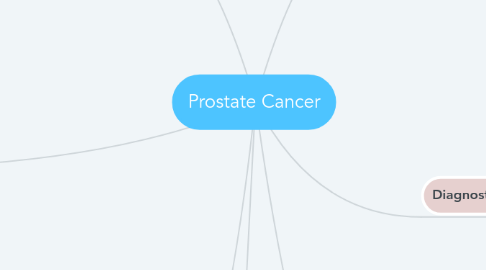
1. Causative Factors
1.1. Genetic Mutations
1.1.1. Inherited mutations of the BRCA1 and BRCA2 gene impair the cell's ability to fix damaged DNA, allowing potentially damaging mutations to persist
1.1.2. HOXB13 gene mutations may result in impairment of the protein's tumor suppressor function, resulting in the uncontrolled cell growth and division
1.1.3. The HPC1 (hereditary prostate cancer 1) gene and the PCAP (predisposing for cancer of the prostate) gene are on chromosome 1
1.1.4. Men with Lynch syndrome (also known as hereditary non-polyposis colorectal cancer, or HNPCC) occur due to a mutation in one of the DNA mismatch repair (MMR) genes and has been linked to prostate cancer
1.2. Chemical exposure such as Agent Orange
2. Risk Factors
2.1. Age: over 50 years old
2.2. Race/Ethnicity: African-American or Caribbean men of African descent
2.3. Diet: high fat, red meat and dairy intake
2.4. Obesity and high BMI
2.5. Smoking
2.6. Geographical Location: most common in North America, northwestern Europe, Australia, and on Caribbean islands
3. Common Findings
3.1. Bladder outlet obstruction: slow urinary stream, hesitancy, incomplete emptying, frequency, nocturia, dysuria
3.2. Blood in the urine or semen
3.3. Erectile dysfunction
3.4. Weakness/numbness in legs
3.5. Advanced stages: bone pain at sites of metastasis, pathologic bone fractures,
3.6. Other symptoms of advance stage: edema of lower extremities, enlargement of lymph nodes, liver enlargement, mental confusion associated with brain metastases
4. References
4.1. Ahmad, A., & Elterman, D. (2017). Can a low-inflammation diet alter prostate health? Evidence points to dietary inflammatory potential's role in prostate cancer development. Urology Times, 45(2), 14-16.
4.2. American Cancer Society. (2017). Prostate Cancer. Retrieved from https://www.cancer.org/cancer/prostate-cancer.html
4.3. McCance, K.L., Huether, S. (2014). Pathophysiology: The Biologic Basis for Disease in Adults and Children, (7th ed). St Louis, MO: Elsevier.
5. Etiology
5.1. More than 95% of prostatic neoplasms are adenocarcinomas
5.2. Most occur in the periphery of the prostate
5.3. Changes occur in the shape and size of the prostate glandular cells, known as the prostate intraepithelial neoplasia (PIN)
5.4. Chronic Inflammation has been linked to prostatic adenocarcinoma as damage from inflammatory responses cause repeated cycles of injury and cell death to the prostate epithelium
5.4.1. Possible causes of inflammation: infection, hormones, physical trauma, urine reflex, certain dietary factors
5.4.2. Inflammation results in prostatic epithelial injury and cellular transformation
5.4.3. This leads to focal atrophy or prostatic intraepithelial atrophy (PIA), which is considered a precursor to prostate cancer
5.4.4. Increase in genetic instability may progress to high-grade prostate intraepithelial neoplasia (PIN) and prostate carcinogenesis
6. Diagnostic Tests
6.1. Blood test: prostate- specific antigen (PSA) > 4 ng/mL
6.2. Digital rectal exam to feel for any bumps/hard areas
6.3. PCA3 urine test: the PCA3 gene is only found in prostate cancer cells
6.4. Transrectal ultrasound to measure size and density of prostate
6.5. Prostate biopsy to determine if malignant, which is then graded based on the Gleason score
7. Treatments
7.1. Active surveillance
7.2. Surgery: total prostatectomy, transurethral resection of the prostate (TURP)
7.2.1. Common choice if cancer has not spread outside prostate gland
7.3. Radiation therapy: external beam radiation or brachytherapy (seed implantation)
7.3.1. Used for low grade cancer just in prostate gland or spread to nearby tissue
7.4. Cryotherapy: use of cold gases to freeze and destroy the prostate
7.4.1. Used to treat early stage prostate cancer or recurrence after radiation therapy
7.5. Hormone therapy or androgen deprivation therapy: goal is to reduce androgens (testosterone and dihydrotesterone) which stimulate prostate cancer cells to grow
7.6. Chemotherapy
7.6.1. Used if cancer has spread outside prostate gland, and hormone therapy is not working

